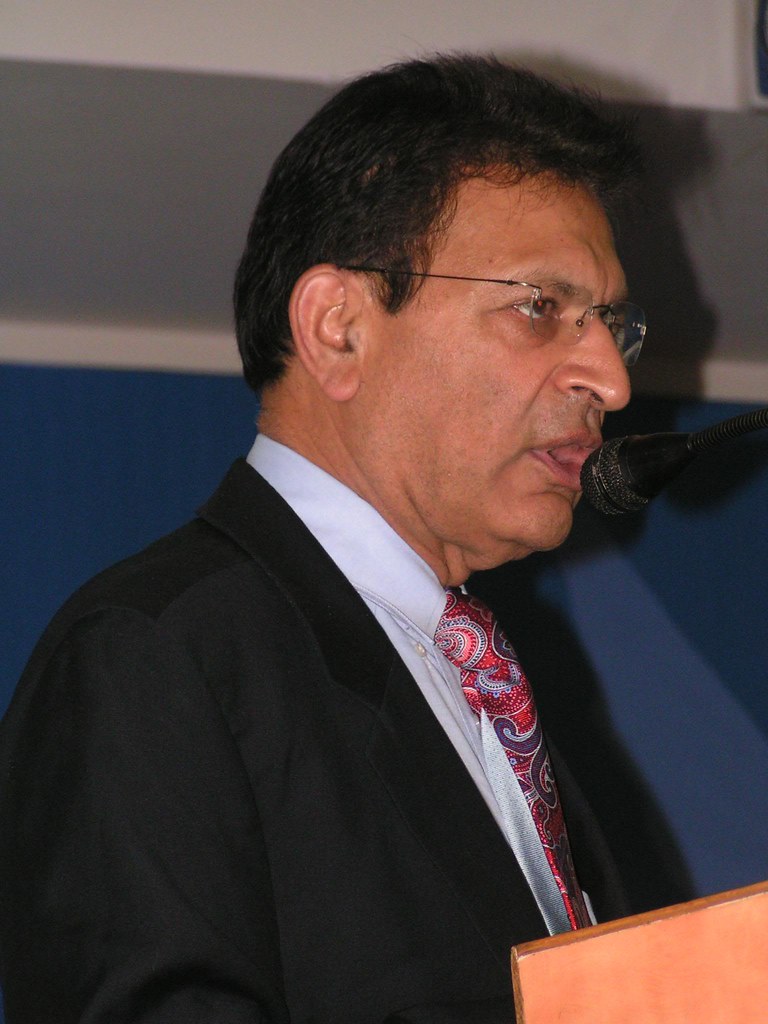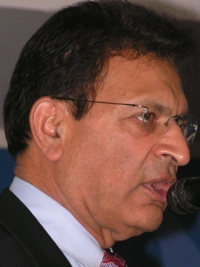
7th INTERNATIONAL CONFERENCE ON PEACE AND NONVIOLENT ACTION
7th ICPNA, Jaipur, November 10 to 14, 2008
5th Plenary Session
12.11.2008
 Speech: "The Three A's" www.herenow4u.net/index.php?id=67083If a non-violent protester is being beaten up with a stick, it is not considered an act of violence to take the stick away. But what if the stick falls to the ground and you break it, is that considered as a violent action?
Speech: "The Three A's" www.herenow4u.net/index.php?id=67083If a non-violent protester is being beaten up with a stick, it is not considered an act of violence to take the stick away. But what if the stick falls to the ground and you break it, is that considered as a violent action?
Is sabotage of the machinery used in war, either during the production or after, considered violence or not?
As I see it, the problems we are facing are not new to humanity. These have been present long before we were born and will be around long after we are gone. Our world is shrinking faster and faster. 100 years ago it took over 45 days to journey by ship from India to America. It took months for Columbus to discover America. But now with the space age, one can travel from US to India in less than 15 hours. With the Internet, news and information are delivered instantaneously. Cultures are spreading faster than the blink of an eye. Eastern cultural effects are sobering westerners and western cultures’ ills are magnified in the east. I see the India which I left 40 years ago and today. These rapid changes have unfolded before my eyes with each successive visit home to India, but taken as a whole, they are indeed breathtaking.
Many of you have said that the changes to society will take place through personal changes and transformations. I agree to that and I want to show you how personal transformation can change families.
Our first Tīrthaṅkara, Ṛṣabha, gave Asi, Masi and Krusi - reading, writing and agriculture - to the world. He, the enlightened one, also knew through his perfect knowledge of what future mankind risked with his greed and ego. In response, he gave three A’s to the world: Ahimsa, Anekāntavāda and Aprigraha.
Ahiṁsā (nonviolence)
Ahiṁsä is a philosophy and strategy for social change that rejects the use of physical violence. As such, nonviolence is an alternative to passive acceptance of oppression and armed struggle against it. Practitioners of nonviolence may use diverse methods in their campaigns for social change, including critical forms of education and persuasion, civil disobedience and nonviolent direct action, and targeted communication via mass media.
Martin Luther King said, "Nonviolence means avoiding not only external physical violence, but also internal violence of spirit. You not only refuse to shoot a man, but you refuse to hate him.”
As a technique for social struggle, nonviolence has been described as “the politics of ordinary people,” reflecting its historically mass-based use by populations throughout the world and history. Struggles most often associated with nonviolence are the non co-operation campaign for Indian independence led by Mohandas Gandhi, the struggle to attain civil rights for African Americans, led by Martin Luther King Jr., and People Power in the Philippines. Not long ago, the 1989 Velvet Revolution in Czechoslovakia saw the overthrow of the communist government.
Anekāntavāda (multiplicity of truth)
Gandhi saw truth as something that is multifaceted and unable to be grasped in entirety by one individual. Even fully liberated Tīrthaṅkaras can’t express truth as it has to come systematically and step by step. Any one entering or leaving in between a sermon or joining in the middle is not going to grasp its full truth.
We assume all attendees will be present and alert, thereby ensuring all have similar experiences and gain a full understanding of the truth. Even if that were the case, we all view things with different glasses based on our own prejudices, so there we also color the truth. There are so many assumptions that this ideal condition of complete truth rests on, that rarely is one ever able to achieve it.
The common man does not grasp the entire truth. Therefore Gandhi believed that all carry pieces of truth, so all need the pieces of others’ truth in order to pursue the greater truth. This led him to believe in the inherent worth of dialogue with opponents, thereby allowing an understanding of motivations. On a practical level, willingness to listen to another’s point of view is often dependent on reciprocity. It is also necessary to have a full understanding of another person’s background for both of them to communicate effectively. Acharya Mahapragya has written excellent books on the Third Eye. Communication is not conducted on a single plane; it is multidimensional taking into account each communicator’s background, state of mind at a given time, hidden agenda besides other points.
Aparigraha (non-possessiveness)
The third concept given by Tīrthaṅkaras is Aparigraha. Parigraha means possessions of materialistic things such as amount of money, jewelry, land, number of cars, houses, servants, cows, horses, personal belongings etc. Tīrthaṅkaras said that one should limit one’s requirements. Set by the individual, once one reaches the limit one has set, he should give away anything in excess of those limits. Thus greed is reduced, as is Karma.
What is Karma? Karma is physical matter found abundantly throughout the universe. Karma in its pure state is inert matter, which has no energy of its own, just the way grass has no kinetic energy. Yet when the same grass is fed to a cow that produces milk, energy is transferred to its consumer, which can then in turn be converted to kinetic energy.
Inert Karma when attracted by the souls’ activity involving Anger, Ego, Deceit, and Greed, Rāga and Dveṣa or cravings and aversion leads to attachment of Karma particles to the soul. A bullet has no energy until it is fired, and in the same way Karma can be charged to have energy. Jainism says that Karma Bandha (bondage) happens with any activity - mental, verbal and physical. In turn Karma can yield fruits of happiness and joy, or sorrow and misery.
It is this Karma which determines our life on this planet. Karma is totally non-biased in giving its fruit. We have control over Karma on how we can reduce the quantity of the effect or potentially even eliminate the effect of Karma.
So to have a better life for now and for the future lives, shouldn’t we be looking at method to reduce the effect of Karma?
As stated earlier, Mana, Vāchana and Kāya (mind, speech and body) are responsible for the attraction of the Karmas. As man thinks, he puts words into verbal action and at a later stage may put it in physical action. Also he gets karma by doing an act, and also by asking others to do it. He also gains Karma when he starts planning the method of execution of his act, collecting equipments for the execution of the act and in its initial step. For example, to kill a tiger he needs gun, ammunition, etc. So he plans on the type and number of guns to buy, setting up tents in a jungle for the hunt and then taking the first step such as lifting the rifle and putting his finger on the trigger. All of these acts are karma gathering acts. Thus there have twenty-seven combinations been described under which one can collect karma.
So how do we prevent it? Let us take a simple example of Anger.
When we are angry we breathe very rapidly. The breathing pattern at the relaxed pace is slow. So if we can watch our breathing then we can control our anger. If we are angry and if we are conscious of ourselves then we will notice our breathing starts rapidly. We can forcefully reduce our breathing and see our anger passing away, fading away. But for that we have to remain conscious. We have to be aware of our emotions and be able to watch ourselves continuously.
We can control ourselves through regular practice of meditation. It is shown through aura photography that the regular meditation gives a white aura to the mediators. One has to be aware of his state of the mind at this very moment. But most of the time we are not living in the current moment. We are living with past memories and future expectations, and letting the Now wander by. Meditation teaches us the technique of being able to use NOW and be in control of NOW thereby enabling a better past and future. It puts one at peace.
When you are at peace with yourself, though you may be actively engaged in daily activities, you are reducing the influx of Karma. Your peaceful attitude even softens the aggressor and he also changes or thinks foolish to carry out any harmful activities. Not only does this reduce tension within you but within your surroundings.
Stephen Covey speaks about proactive in his book The Seven Habits of Highly Effective People. Being proactive is about taking responsibility for your life. You can't keep blaming everything on your parents, society etc. Proactive people recognize that they are "response-able." Proactive people focus their efforts on their Circle of Influence. They work on the things they can do something about: peace with themselves first. Their success is seen and felt by others and changes take within their circle of influence. This then grows from families to friends to communities, villages, towns, cities, nations and the world.
At the center of non-violence stands the principle of love.
- Martin Luther King
If you will practice meditation on a regular basis you will develop unconditional love for all. At the end of the meditation one develops love and friendship for all. Vipassana meditation ends with Mitta Bhavana (A feeling of friendship and compassionate feeling) for all.
Next time after completing your mediation, repeat something like this:
May all enjoy peace and harmony, peace and harmony, peace and harmony!
May all be liberated, liberated, liberated from all their miseries, all their bondages and Saṁskāras (Karmas).
May all be Happy, Happy, Happy.
OṀ Śantī
Education is a vaccine for violence.
- Edward James Olmos
 Kirit C. Daftary
Kirit C. Daftary